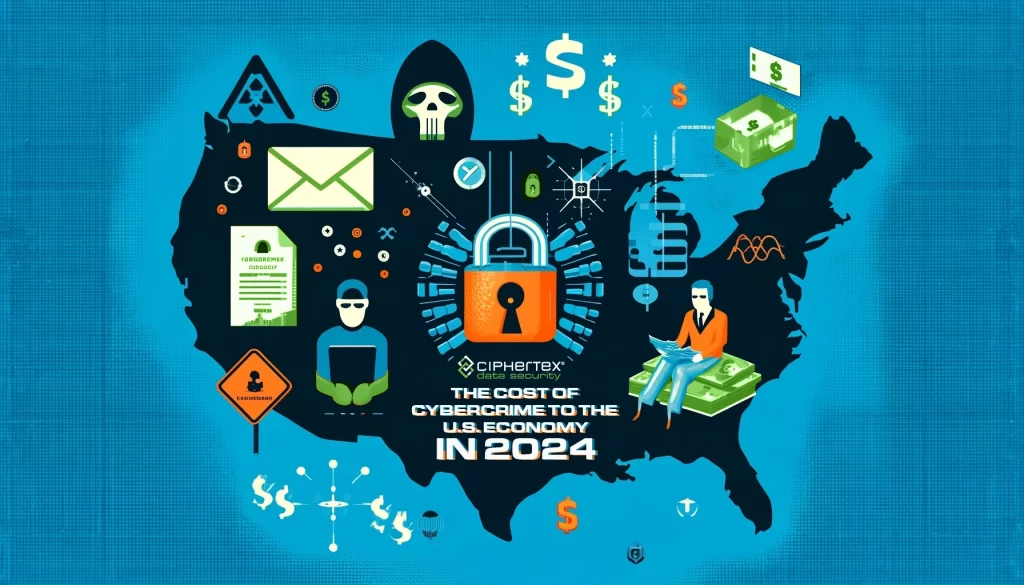The cost of cyber theft remains significant to the U.S. economy. Consequently, the rise in ransomware, phishing, and data breaches has caused a staggering financial toll on businesses and individuals. This blog explores the latest data on the economic impact of cybercrime, the types of attacks most prevalent today, and the steps needed to mitigate these threats.
The Financial Impact
The average cost of a single cybercrime incident in the United States is approximately $27.37 million (Astra Security) (ExpressVPN). This figure includes expenses related to data recovery, legal fees, regulatory fines, and reputational damage. On a national scale, cybercrime costs the U.S. economy hundreds of billions of dollars annually. In 2023, the estimated cost was around $320 billion (Astra Security). In 2024, the cost is projected to be significant, with cybercrime damage costs continuing to rise globally, emphasizing the growing threat of cyberattacks.
Types of Cyber Attacks
Cyberattacks come in various forms, each with unique methods and impacts. Here are some of the most common types:
1. Phishing
Phishing attacks involve cybercriminals impersonating legitimate organizations to steal sensitive information. These attacks account for nearly 39.6% of all email threats and can lead to identity theft, financial fraud, and unauthorized access to secured systems (ExpressVPN).
AI-Driven Phishing: Cybercriminals are leveraging publicly available and custom-made AI tools to orchestrate highly targeted phishing campaigns. These AI-driven phishing attacks craft convincing messages tailored to specific recipients, using proper grammar and spelling to increase the likelihood of successful deception and data theft.
2. Ransomware
Ransomware encrypts a victim’s files, rendering them inaccessible until a ransom is paid. Additionally, the average cost of an attack is $4.54 million, including $1.85 million in recovery expenses. These attacks often target entire networks, leading to significant financial and operational disruptions (ExpressVPN).
3. Distributed Denial of Service (DDoS)
DDoS attacks overwhelm online services with traffic from multiple sources, causing service disruptions. In 2023, DDoS attacks increased significantly, particularly targeting retail, shipment, and public relations websites (ExpressVPN).
4. Data Extortion
In data extortion attacks, cybercriminals steal sensitive data and threaten to release it unless a ransom is paid. Moreover, this type of attack poses a significant threat to both individuals and businesses, as it involves the theft and potential public exposure of sensitive information (ExpressVPN).
Voice and Video Cloning: In addition to traditional phishing tactics, malicious actors increasingly employ AI-powered voice and video cloning techniques to impersonate trusted individuals, such as family members, co-workers, or business partners. By manipulating and creating audio and visual content with unprecedented realism, these adversaries seek to deceive unsuspecting victims into divulging sensitive information or authorizing fraudulent transactions.
The Broader Economic Impact
The ongoing wave of cyber theft has far-reaching consequences for the U.S. economy. Beyond immediate financial losses, these attacks undermine economic growth, reduce competitiveness, and lead to job losses. The continuous transfer of wealth from the U.S. economy to cybercriminals and adversaries is a significant concern, described as a “death by a thousand cuts” (Council on Foreign Relations).
Mitigation Strategies
To combat the rising threat of cyber theft, businesses and individuals must adopt robust cybersecurity measures. Key strategies include:
· Enhanced Cybersecurity Training: Educating employees about phishing and other common cyber threats.
· Regular Software Updates: Ensuring all systems and software are up-to-date to protect against vulnerabilities.
· Advanced Security Solutions: Implementing advanced security technologies such as AI-based threat detection and response.
· Incident Response Plans: Developing and regularly testing incident response plans to quickly address and mitigate the impact of cyber attacks.
· Data Network Security: Strengthening network defenses to protect against unauthorized access and DDoS attacks.
· Enterprise Data Encryption: Encrypting sensitive data to ensure it remains secure even if intercepted by attackers.
· Enterprise Security Data Models: Utilizing sophisticated models to monitor, detect, and respond to security threats in real-time.
Conclusion
Cyber theft continues to pose a significant threat to the U.S. economy in 2024, with the average cost of incidents reaching tens of millions of dollars. By understanding the types of attacks and adopting proactive cybersecurity measures, businesses and individuals can better protect themselves against this growing menace.
For more information on cyber theft and cybersecurity trends, visit the sources referenced in this blog:
